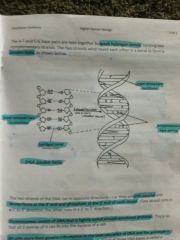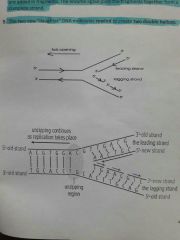![]()
![]()
![]()
Use LEFT and RIGHT arrow keys to navigate between flashcards;
Use UP and DOWN arrow keys to flip the card;
H to show hint;
A reads text to speech;
5 Cards in this Set
- Front
- Back
- 3rd side (hint)
|
Structure of DNA |
DNA are made from repeating units called nucleotides, Thymine, adenine, guanine and cytosine The nucleotides are held together by strong sugar-phosphate bonds to form a sugar-phosphate phosphate backbone.
Complementary base pairing= a and t and c and g
The base pairs are held together by weak hydrogen bonds
The two stands wind around each other to form a double helix |

|
|
|
Structure of DNA 2 |
The two strands of DNA run in opposite directions ie they are anti-parallel with deoxiribose at the 3' and phosphate that the 5' end Chromosomes consist of DNA that tightly coiled around associated proteins. All cells store their genetic information in the base sequence of DNA and the genotype is determined by the sequence of DNA bases. DNA is the molecules of inheritance and can direct it's own replication. |
|
|
|
DNA replication |
Prior to cell division, DNA is replicated by a DNA polymerase. This process occurs at several locations on a DNA molecule DNA polymerase and ligase In order for replication to take place the following must be present: 1) DNA to act as a template for the new DNA molecule 2) Primers 3) Enzymes - DNA polymerase and ligase 4) A supply of all 4 different nucleotides 5) ATP to supply energy |
|
|
|
DNA replication 2 |
DNA is unwound and unzipped to form two single template strands. DNA polymerase needa a primer to start dna replication. Dna polymerase can only add free complementary DNA nucleotides to the deoxiribose 3' end of a DNA strand. This results in one of the strands of DNA being replicated continuously- this is called the leading strand. The other is replicated in fragments. The fragments are then joined together by the enzyme ligase - this is called the lagging strand. |
|
|
|
The stages of DNA replication |
1) the original DNA molecule unwinds out of the double helix structure. 2) the weak hydrogen bonds between the base pairs break allowing the two DNA strands to 'unzip' and separate away from each other to form two template strands. 3) A primer attaches to one end of each exposed DNA template strand. 4) Tis initiates DNA polymerase to add "free" DNA nucleotides to align themselves next to their complementary base pair onto the 3' end of the growing number strand (the leading strand) 5) a pairs with t and c pairs with g 6) New hydrogen bonds are formed between the newly created base pairs. 7) New strong chemical (sugar phosphate) bonds form between the nucleotides, forming the backbone. 8) On the lagging strand, Primers are added as the fork widens and the DNA nucleotides are added in fragments. The enzyme ligase joins the fragments together to form a complete strand. 9) The two new daughter DNA molecules rewind to create two double helix helices. |

|

